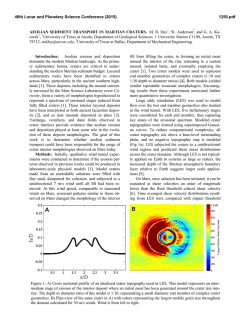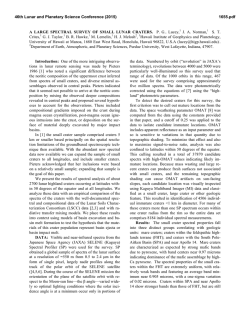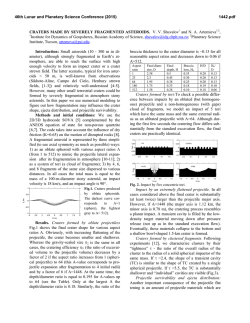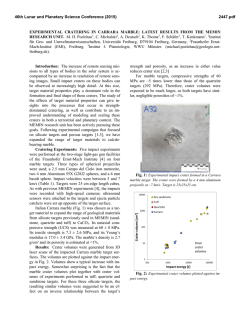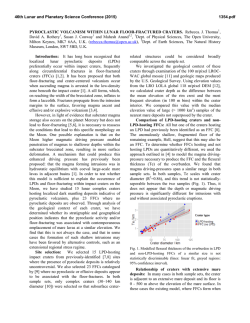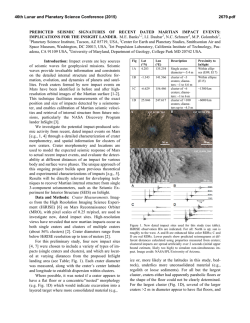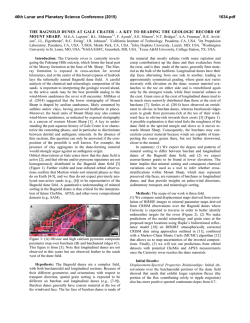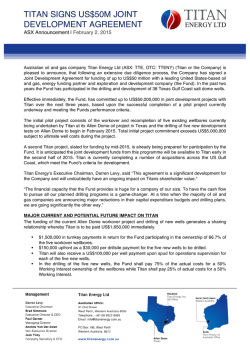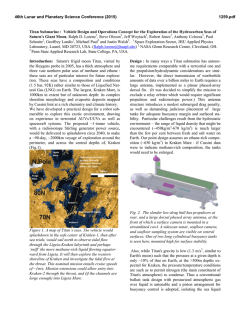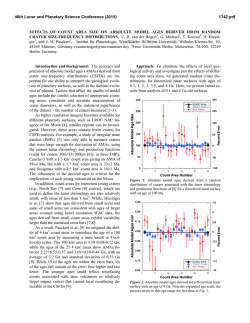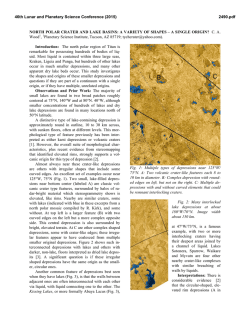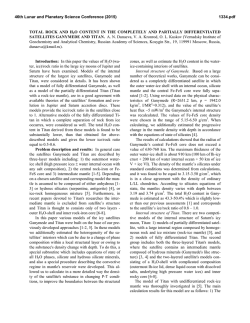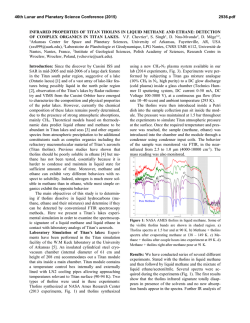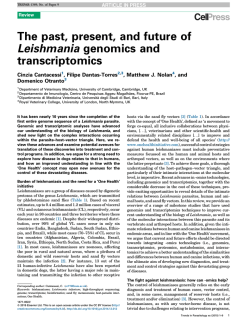
THE EFFECTS OF LOW THERMAL CONDUCTIVITY SAND ON THE
46th Lunar and Planetary Science Conference (2015) 2913.pdf THE EFFECTS OF LOW THERMAL CONDUCTIVITY SAND ON THE RELAXATION OF TITAN’S CRATERS Lauren R. Schurmeier1 and Andrew J. Dombard1, 1Earth & Environmental Sciences, University of Illinois at Chicago (854 W. Taylor St., Chicago, IL [email protected]). Introduction: The surface of Saturn’s moon Titan is unlike most satellites because the surface processes that occur are not dominated by impact cratering, but instead by aeolian, lacustrine, fluvial, and pluvial processes. Impact craters on Titan are neither common nor evenly distributed. So far only 8 of the roughly 60 crater candidates identified on Titan have been named as impact craters [1]. Recently, Neish et al. [2] used Cassini SARTopo data to create topographic profiles of the craters Ksa, Sinlap, Hano, Afekan, Menrva, Soi, and two “probable” unnamed craters identified by Wood et al. [1]. With the exception of Hano, these all lie within 30° of the equator, which is also the location of Titan’s large sand seas of linear dunes. Neish et al. [2] constrained crater depth, rim height, and diameter, permitting assessment of crater morphology. Notably, the depth-todiameter ratios are significantly shallower than similarsized fresh craters on Ganymede [3], a moon of comparable size and composition. Titan’s craters initially should have had similar depths to that of fresh Ganymede and/or Callisto craters, but over time, one or more unknown processes shallowed them by many hundreds of meters. Causes of the shallowing could include: erosion and deposition by rain and rivers, direct atmospheric sedimentation of haze particles, aeolian infill of dune material, and viscous relaxation. Neish et al. [2] concluded that aeolian infill alone was likely the cause of the shallowness of Titan’s craters, and rejected the idea of topographic relaxation because of Titan’s low surface temperature. Here, we test this assumption and determine if the unique thermal properties of Titan’s sand could aid viscous relaxation and result in shallower craters in a reasonable period of time. The Thermal Conductivity of Titan’s Sand: Titan’s sand seas are thought to be composed of hydrocarbon sands [4]. Solid hydrocarbons, such as benzene or coal, have very low thermal conductivities, and solidorganic sands are also very porous in nature, leading to an even lower bulk thermal conductivity. We estimate the thermal conductivity of the hydrocarbon sands by scaling the thermal conductivity of benzene and coals at temperatures and pressures relevant to Titan by a factor commiserate with the conductivity drop between particulate and solid silicates. Since the craters lie within the regions containing sand seas, they may be surrounded by and filled with sand, and the low thermal conductivity of the sand acts as a blanket that might raise the effective surface temperature of Titan’s craters, potentially enhancing relaxation. The final crater morphology thus would be shallowed by both infill and relaxation. Sinlap and Soi: Of the identified craters with available topographic profiles, Sinlap and Soi are most similar in diameter (~80 km), but they currently have immensely different depths that are shallower than the expected ~1100 m for a crater this size. Sinlap has a depth that suggests a shallowing of nearly 500 m, while Soi has lost almost all of its topography and is shallowed by about twice as much. Soi’s topography is almost indistinguishable from the adjacent dune field and appears to be filled with dune material. Additionally, Soi appears to have linear dunes present much closer to its rim than Sinlap (Fig. 1). The difference in the location of the dunes, the relative ages of the craters, and the amount of dune material within the craters may have lead to differences in crater relaxation resulting in dissimilar crater depths. ! Figure 1: Cassini SAR images of Sinlap (left) and Soi (right). The striped radar-dark features are linear dunes. The dunes are located closer to Soi’s rim than Sinlap’s. Image credit: C. Neish/NASA/JPL-Caltech/ ASI/GSFC Methods: Our aim is to determine if we can reproduce the current shallow depths of Sinlap and Soi. Initially, we considered a uniform increase in surface temperature, which might arise from a blanket of sand of uniform thickness [5]. The thickness of sand deposits around a crater, however, will be spatially variable, a scenario we consider here. Differences in the amount of dune infill in the crater bowl and the proximity of nearby dunes to the crater rim are investigated. Dune Field Effective Surface Temperature: The location of nearby dunes influences the surrounding surface temperature profile around the crater and will not yield a constant effect because of variable dune thickness. The horizontal scale of the dunes (hundreds of meters), however, is orders of magnitude smaller than the craters, so we seek to determine an effective increase in surface temperature appropriate to study the relaxing craters. To determine this effective surface 46th Lunar and Planetary Science Conference (2015) temperature produced by the dune field, we use the commercially available Marc finite element package. We produce meshes that crosscut 3 linear dunes with 5 surrounding interdune spaces to simulate their thermal effects at depth. The physical surface is held at 94K, and we find the thermal conductive equilibrium using our estimated conductivity of Titan’s sand. Dune shapes are assumed to have isosceles triangular shapes through their cross-section with maximum measured dune heights of 120-180 m, and widths and spacing (empty interdune areas) from globally averaged measurements along with measurements specifically in the vicinities of Sinlap and Soi [6]. We investigate different permutations of dune widths, interdune widths, and maximum dune heights and find the equilibrium temperature at depth. Thus, we determine a temperature of 100 K is most representative of the effective surface. Crater Relaxation: We also use Marc to simulate the relaxation of Sinlap and Soi, assuming axisymmetry (see [7]). Sinlap’s diameter, depth, and rim height are determined from the profiles in Neish et al. [2]. Both craters have similar diameters within error, ~80 km. To determine the initial, unmodified shape of both Sinlap and Soi, we use the expected depth from the depth-to-diameter relationships of fresh craters on Ganymede and Callisto, averaging them [3]. The viscoelastic relaxation is modeled using the rheology of water ice at two heat flows: 4 mW/m2 (a reasonable heat flow for Titan today [8]), and a higher heat flow of 10 mW/m2 more appropriate for the distant past or higher than chondritic abundances of heat producing elements. We simulate relaxation up to 4 Gyr for various increased surface temperatures within the crater bowl. To calculate the increase in surface temperature within the bowl, we select a maximum infill thickness and assume that the infill is flat (Fig. 2). Using the thickness at each location within the bowl, we calculate the increase in surface temperature using the estimated thermal conductivity of the sand. The approximate distance of the adjacent dune field to the rims of Sinlap and Soi are measured from SAR imagery. We find both minimum and maximum distances to the dunes and run both for comparison. We set the surface temperature to 100 K from the starting distance of the dune field out to the end of the mesh. Note that the dunes adjacent to Soi are much closer its rim than the dunes near Sinlap’s (Fig. 2). For each run, we determine the minimum crater bowl depth at each time step during crater relaxation. However, the actual depth of the crater is reduced because of the thickness of sand infill in the crater raises the apparent crater depth. We reduce the final depth needed by subtracting the maximum thickness of sand infill. We then determine the amount of relaxation time needed to reach this reduced depth. 2913.pdf Figure 2: Initial crater shape of both Sinlap and Soi (black curve). Effective surface temperatures within the crater bowl are calculated from the thicknesses of overlying sand infill at multiple locations. The location of the adjacent dune fields for Soi and Sinlap are shown (arrows) and are assumed to produce an effective surface temperature of 100 K. Preliminary Results: We find that at Titan’s expected heat flow [8] of 4mW/m2, Sinlap requires sand thickness that is 82% of the depth change required (375 m) to relax the remaining 85 m in just under the expected maximum age of the dunes, 750 Myr [9]. If 98% filled with sand, it only takes 300 kyr to relax the final 10 m, but at that level of sand fill, viscous relaxation is a negligible contributor. If Soi is 69% filled with sand (525 m), it can relax the remaining 258 m and eliminate all topography in under 750 Myr. When 92% filled with sand, Soi can reach its current depth in 1.2 Myr. At a higher heat flow of 10 mW/m2, if Sinlap is 60% filled with sand, viscous relaxation will uplift the remaining 185 m in just under 750 Myr. If 87% filled with of sand, the remaining 60 m of uplift can occur in 325 yr. If Soi is 69% filled with sand it can relax to its current state in a mere 3 kyr. We also find that the location of adjacent dunes is not an important factor in relaxation. Our results show that viscous relaxation aided by Titan’s sand is a minor contributor to Sinlap and Soi’s shallowness at Titan’s current heat flow estimate. Increased heat flow in Titan’s past or because of higher heat sources makes viscous relaxation more important; however, aeolian infill contributes the most to the shallow depths of Sinlap and Soi. Later simulations will establish whether this finding holds for other craters. References: [1] Wood C. A., et al. (2010) Icarus, 206, 168-172. [2] Neish C. D. et al. (2013) Icarus, 223, 82-90. [3] Schenk, P. (2002) Nature, 417, 419-421. [4] Soderblom, L. A., et al. (2007) Planetary & Space Sci., 55, 2015-2036. [5] Schurmeier, L. R. and Dombard, A. J. (2014) Titan Through Time 3 Abstracts. [6] Savage, C. J., et al. (2014) Icarus, 230, 180-190. [7] Dombard, A. J. and McKinnon, W. B. (2006) JGR, 111, E01001. [8] Sohl, F. et al. (2003) JGR, 108, E12 [9] Rodriguez, S. et al. (2014) Icarus, 230, 168-179.
© Copyright 2025

